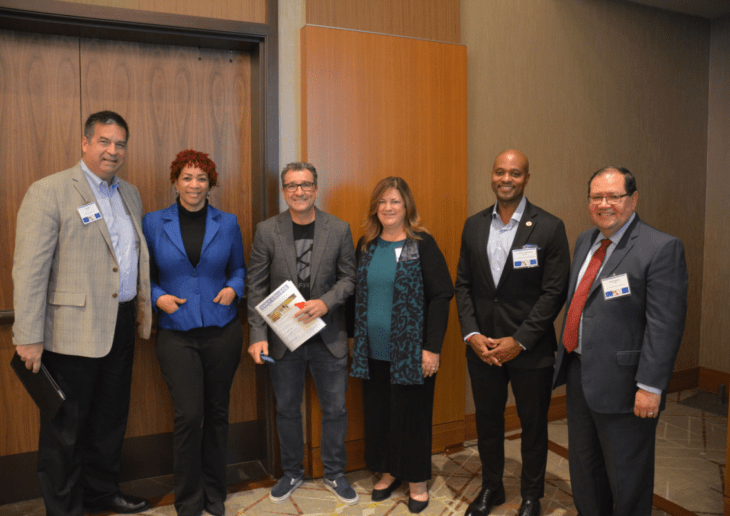Collaboration is Key: The Inaugural California Regions at Work Conference Feature Story
January 18, 2024

Working together, sharing expertise, and pooling resources for student success were key themes throughout the more than 25-panel discussions and presentations at the Inaugural California Regions at Work Conference, held Dec. 6-8 in Anaheim and hosted by the Orange County Regional Consortium (OCRC).
“This conference provided opportunities to create new collaborative partnerships, share and adopt innovative practices and resources, and learn more about the work taking place across the state,” said Adriene “Alex” Davis, Ed.D., Assistant Vice Chancellor of Economic and Workforce Development in Educational Services at Rancho Santiago Community College District and OCRC Executive Director.
Rich with expertise from across the state, conference presenters addressed the issues that directly impact the work preparing students to earn a living wage and supporting economic development. College presidents, faculty, administrators, state legislators, and business and industry leaders spoke about the state budget, data collection, employer engagement, marketing, industry partnerships, and artificial intelligence, to name a few. Participants learned about the exciting work happening in initiatives such as the K-12 Workforce Program, Regional Centers for Excellence, and Career Education partnerships.
Marvin Martinez, Chancellor of the Rancho Santiago Community College District (RSCCD), who delivered the keynote address and spoke at the Chief Executive Officer panel, reminded participants that the community college mission is to prepare students to transfer to four-year universities and to prepare students for jobs.
“Most colleges like to focus on transfer. We were structured and created as a system to create and contribute to economic development,” Martinez said. “Our colleges are doing two things really well. We are creating a number of programs in water technologies, and we have a number of programs in workforce development. What we are also doing really well is hiring incredible people, administrators who know how to work with industry.” Martinez emphasized the importance of meeting with business leaders in person and at their sites to hear and see what their needs are and to improve curriculum and develop programs. “You can’t do that from your office.”
One example Chancellor Martinez pointed to is his district’s apprenticeship program, which gives students a chance to make a living in in-demand fields while getting on-the-job training under the supervision of industry professionals. Industry partners gain a stream of experienced workers while students earn a “Certificate of Completion” from the State of California, which officially designates the apprentice as a skilled journeyworker.
Jeff Ball, Chief Executive Officer of the Orange County Business Council, said the council does a lot of work to educate the business community about the many training programs and the importance of their education partners.
“One of the most critical partners for us in the business community is the community college system,” Ball said. “In Orange County, we are blessed to have four strong districts already doing a significant amount of work around workforce development. Our focus now is how we can leverage the work that’s being done and how we can bring businesses to the table in a constructive way so that we can be thinking about the workforce demands, not just today, but five years and ten years from now.”
In another discussion, the Regional Center of Excellence Panel dove into data collection and how it is used to shape curriculum, improve instruction, and show the colleges’ effective use of funding.
Tina Ngo Bartel, director of the San Diego and Imperial Center for Excellence for Labor Market Research, discussed the Faculty Institute, designed to teach faculty data literacy and help them use data in their work. The center provides institute participants with a dashboard and data specific to their courses, including enrollment information and demographics of all students, including those who dropped out. This information allows faculty to uncover areas of possible unconscious bias and better understand if they are missing opportunities to provide students with assistance. A similar Counselor Institute is in development.
Jacob Poore, director of the OC Center of Excellence in Labor Market Research, talked about their recently released Orange County Labor Market Overview, which analyzed resilient and in-demand jobs to better understand how economic upheavals, like the one caused by the COVID pandemic, impact Orange County. “We want colleges to be prepared and get students into those good, resilient, high-paying jobs,” Poore said.
One of the biggest challenges facing education, specifically community colleges, is the 2024-25 California state budget deficit. Senator Tom Umberg, District 14, addressed the estimated $68 million shortfall, which has since been reduced in the governor’s recently released spending plan to a still concerning $37.9 million, at the Legislative Panel Discussion, moderated by Dr. Julianna Barnes, Chancellor of South Orange County Community College District. Presenters noted the money is still available, but colleges will have to work harder to get it.
President of Santiago Canyon College, Dr. Jeannie Kim, said colleges must look at alternative funding sources, such as federal grants, private partnerships, and shared resources. “We have to be creative and innovative,” Kim said. “We have to be courageous, and we have to be willing to break the mold.”
Kim also shared her bold vision for career education to ensure that CTE graduates can advance professionally.
“As someone who really believes in socioeconomic mobility, I know that these frontline jobs that we are preparing our students for are super important, but I want to make sure that the students have a pathway, an onramp, on to those supervisorial, managerial and CEO positions,” Kim said. “We as higher education professionals, in partnership with our business and industry partners, must design that pathway explicitly,” Kim said educators and business leaders need to talk about the specific skill sets students need to move into supervisorial roles and allow them to grow professionally. “That ceiling exists. We have to do something in higher education to break through it. We need to make sure they get to those top-level jobs and that’s how we make change. That is the big conversation I am having with business and industry, to make sure they understand we are working together to make that happen.”
Attendees said they were excited to hear about the many innovative programs and initiatives discussed at the conference, including partnerships with companies such as Intel, Amazon, and Cyberforward Academy, whose CEO Mike Gentile was a panelist.
To John Jaramillo, dean of Economic and Workforce Advancement at Saddleback College and conference co-host, the benefits of collaboration for Orange County’s students and businesses are clear.
“There are many great activities both in our region and neighboring regions. The scope of what we do in economic workforce and development is vast. We can’t do it all individually, so we need to collaborate even more than we think we are doing,” Jaramillo said. “Let’s look beyond the obvious and see how we can help communities address their workforce needs as well as help individuals be successful in life by getting the skills and abilities they need.”




